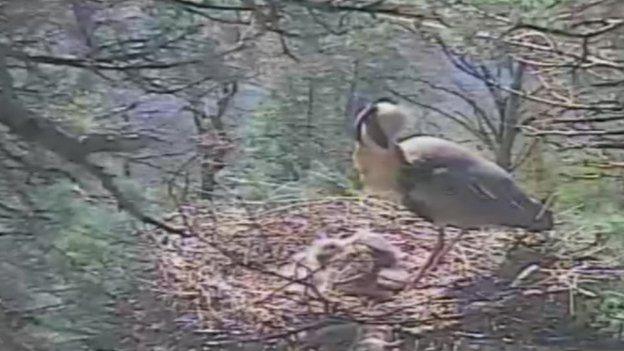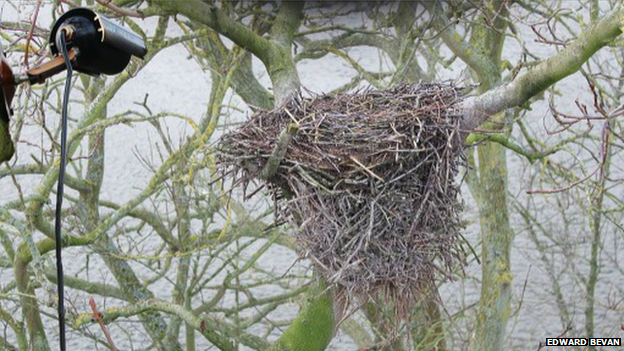Ellesmere herons race for survival
- Published
- comments

A colony of about 25 pairs of herons nest at Ellesmere
Herons are recognisable birds and many of us will have seen one launching gracefully into the air from the edge of a river. They tend to fly fairly slowly, retracting their long necks into a distinctive s-shape while airborne.
Since we often see them in the distance you may be surprised to learn just how big they really are.
After the swan they are our largest common bird, standing a metre tall with a wingspan that can be twice that. You only really get a sense of their size if you can get close to one.
And this week for Springwatch on BBC Midlands Today that's just what I was able to do.
'Huge gamble'
I went to Ellesmere Heronwatch, external in Shropshire to get up close with one of my favourite birds. The project allows visitors to see right inside the heronry itself and it's currently celebrating its 25th birthday!
The heronry is on Moscow Island, built by the local landowner in 1812.
When the herons arrived 25 years ago the RSPB helped with a temporary building and binoculars to watch them. These days the operation is much more high-tech with a host of cameras in the trees looking right into the herons' nests.
The cameras give a great view which makes you appreciate just how big herons are and how much growing the chicks have to do before their first winter. From just 10cm (4in) tall at birth to a metre (3ft) a few months later.
So to give their offspring the best start in life herons lay their eggs very early in the year. That can mean eggs appearing at the end of February.

Webcams have been installed on trees on Moscow Island
This is a huge gamble and it doesn't always pay off.
Signs of recovery
Two years ago the very cold winter meant hard times for all our herons, including those in Ellesmere.
The parents on every nest in the heronry eventually abandoned their newly hatched chicks to go and find food for themselves. With no parents to feed them the chicks didn't make it.
Since it takes two years for herons to start breeding at Heronwatch, external we're just seeing the impact of the bad winter of 2013 on breeding pairs. But it looks like we are also seeing signs of a recovery with 11 chicks fledging this year. Some may have already left their nest.
Watching heron chicks in February and March can be a cold and tricky pursuit and by the time the weather warms up the spring leaves on the trees block your view.
Heronwatch beams the pictures right into the café near Moscow Island, providing what locals call their very own bird-based soap opera.
Finally let's end with my favourite heron fact, the collective noun for herons is "a siege".
- Published6 February 2015
- Published29 October 2014